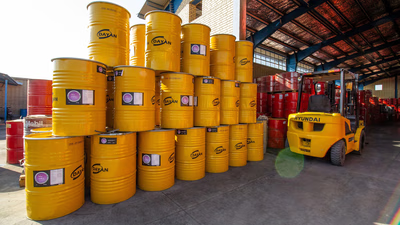
Base oil is essential for lubricants and industrial applications.
Base oil refers to a type of oil that is used as a primary ingredient in the production of lubricants, such as motor oils, hydraulic fluids, and industrial oils. It is a refined petroleum product obtained from crude oil through a process called refining or distillation. Base oil serves as a base or foundation for the formulation of different types of lubricants. It possesses certain desirable characteristics, such as high viscosity index, thermal stability, oxidation resistance, and low volatility. These properties help ensure that the lubricants made from base oil can effectively reduce friction, protect moving parts, and provide smooth operation of machinery and equipment.
Base oil is an oil that is considered as a base for lubricant. The most important component of lubricants in terms of volume is the base oil and in terms of weight, on average, more than ninety-five percent of the formulation of a lubricant. Recommended for use in the production of automotive and industrial oils, oils and greases, rubber products, white oils and paraffin oils, etc. In some lubricants (compressor and hydraulic oils) 99% of the oil is base oil and only 1% of it is additives. Base oils can be obtained from petroleum or non-oil sources. Most of the base oils consumed in the world come from refining crude oil. The main constituents of base oils are paraffinic, naphthenic and aromatic compounds.
Base oil is the most important element in the formation of lubricants in terms of volume, so announcing that the share of base oil in the efficiency of the final lubricant is increasing day by day is not far from reality. In this regard, we can refer to turbine oil, of which more than 99% is base oil. Modern lubricants are made from a wide range of base liquids and chemical additives. The base liquid has several functions, but is primarily a lubricant, providing a layer of fluid that separates moving surfaces or dissipates heat and coats the particles while minimizing friction. Many lubricating properties are enhanced or created by adding special chemical additives to the base liquid.
Base oils can be obtained from oil or non-oil sources, but most of the world's base oils are made from oil refining. The properties of petroleum-based base oils depend on the type of crude oil and how it is refined. Therefore, oil, like crude oil, consists of various substances and compounds, the main components of which are paraffinic, naphthenic and aromatic compounds.
Base oils are typically categorized into different groups based on their refining process and composition. The most common classification system is the API (American Petroleum Institute) base oil classification system, which includes five groups: Group I, Group II, Group III, Group IV, and Group V. Each group has specific characteristics and performance levels, with Group I being the least refined and Group V consisting of various specialty oils. In addition to petroleum-based base oils, there are also synthetic base oils, such as polyalphaolefins (PAOs), esters, and polyalkylene glycols (PAGs), which are chemically synthesized and offer enhanced performance properties compared to traditional mineral-based oils. Synthetic base oils are commonly used in high-performance lubricants, including those used in extreme temperature or high-pressure applications.
-

Base oil is primarily consumed by the lubricant industry, which includes automotive, industrial, marine, and aviation sectors. Its demand is closely linked to lubricant consumption, driven by factors such as industrial growth, vehicle sales, and machinery maintenance. The automotive sector significantly influences base oil demand due to the number of vehicles on the road and their maintenance needs. Industrial activities like manufacturing and construction also rely heavily on lubricants derived from base oil. Base oil is produced through refining crude oil or chemical synthesis and serves as a key raw material for engine oils and industrial lubricants. The production process involves heating crude oil to separate lighter hydrocarbons for fuels while heavier ones are refined into base oils. Additives are incorporated to enhance properties like friction resistance and cleaning capabilities. Market trends indicate a growing shift towards high-performance and environmentally friendly lubricants, affecting specific base oil grades" demand.
Regional variations in industrial activity and economic development influence base oil consumption patterns, with emerging economies experiencing increased demand due to rapid urbanization. Additionally, recycling processes for used lubricants are gaining traction, providing sustainable alternatives that may impact virgin base oil demand. "
-

Base oil is a crucial component in the formulation of lubricants, primarily derived from refined petroleum. It constitutes over 95% of most lubricants, including motor oils and hydraulic fluids. The refining process yields base oils with desirable properties such as high viscosity index, thermal stability, and oxidation resistance, which are essential for reducing friction and protecting machinery. Base oils can be categorized into five groups by the American Petroleum Institute (API), ranging from less refined to specialty oils. While most base oils are petroleum-based, synthetic alternatives like polyalphaolefins and esters are gaining popularity due to their superior performance in extreme conditions. The increasing reliance on base oil in lubricant efficiency highlights its significance in the industry.
-

West Asia, particularly the Middle East, is a crucial hub for base oil production due to its vast crude oil reserves and advanced refining infrastructure. Saudi Arabia leads the region with its extensive refining capabilities, primarily through Saudi Aramco, which produces various grades of base oils. The UAE follows closely, with significant contributions from ADNOC and ENOC, focusing on high-quality base oils. Iran also plays a vital role in this sector, leveraging its historical oil production and refining expertise through the National Iranian Oil Company (NIOC). Other countries like Kuwait, Qatar, and Oman are also notable producers, each with their own state-owned entities managing oil production and refining. The region"s strategic location and investments in modern refining technologies ensure a steady supply of base oils to meet both regional and global demands. Base oils produced in West Asia adhere to international certifications such as ISO 9001 and ISO 14001, ensuring quality standards are met. The complexity of producing engine oils involves not just base oils but also various additives that enhance lubrication properties.
As the industry evolves, new standards are being developed to optimize fuel efficiency and reduce engine wear. "
-

Base oils have a rich history dating back to ancient civilizations, where lubricants were derived from animal fats and vegetable oils. The modern era of base oils began in the 19th century with the rise of the petroleum industry, driven by significant oil discoveries and advancements in refining techniques. Initially, crude oil-based lubricants were not favored due to their inferior performance compared to animal-based options. However, as automobile demand surged, manufacturers began optimizing crude oil processing to produce better lubricants. By the early 20th century, engine oils were classified by viscosity, leading to a focus on refining for improved efficiency. The American Petroleum Institute established a classification system for base oils based on refining methods and properties. Over time, innovations such as solvent extraction and hydroprocessing enhanced base oil quality. The introduction of synthetic base oils in the mid-20th century marked a pivotal shift in lubricant technology, offering superior performance for various applications including automotive and industrial uses. Today, ongoing research aims to develop environmentally sustainable base oils that meet modern engine requirements.




